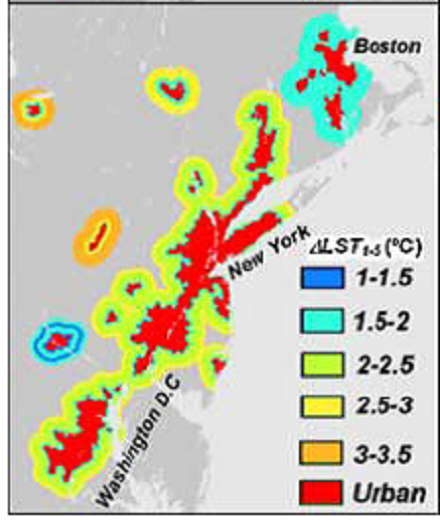When we think about climate change impacts in cities like Boston, we often envision dumpsters floating in the Seaport or flooding on Morrissey Boulevard. However, exposure to extreme heat results in more emergency room visits, more hospital admissions, and more deaths than hurricanes, floods, and tornadoes combined.
Heat is a silent killer and as summers get hotter, particularly in the Northeast US, staying safe during heat waves is increasingly challenging. Recent research by the C-HEAT team from Boston University’s School of Public Health and GreenRoots show that temperatures indoors are often higher than outdoors – particularly in low-income homes. There is an urgency to leverage policies to reduce extreme temperature exposures, and a unique opportunity to leverage investments that are focused on lowering carbon emissions to also address extreme heat where we live, work, and play.
From clean investment funds to low-income solar programs to heat pump grants, hundreds of millions of dollars from all levels of government and the private sector are flowing to lower our carbon emissions and keep climate change in check. However, these investments could substantially increase our resilience to extreme heat if we are intentional about how they are deployed.
There are a few notable examples of places where people are already taking advantage of these mutual benefits.
Weatherization and Heat Pumps
Decarbonizing heating through air source heat pumps combined with weatherization are key emission reduction strategies for buildings, which are the largest emitter of greenhouse gasses worldwide. However, heat pumps can also play an important heat resilience role by adding air conditioning to places where cooling wasn’t previously an option. This is particularly important for low-income, energy-inefficient housing where residents, who may be extremely vulnerable to heat stress, are often unable to afford the electricity bills necessary to run an air conditioner. Heat pumps are currently more expensive than traditional air conditioning window units, but they are much more efficient.
To be able to scale this intervention, we need targeted incentives – particularly for low-income residents living on “heat islands” and energy-inefficient housing. These investments would make this technology affordable – and by targeting some of the most inefficient housing – would have a disproportionately positive effect on greenhouse gas reductions.
New York City’s Housing Authority is an example of an agency working to increase its residents’ heat resilience while lowering the agency’s greenhouse gas emissions. The authority is currently working on a pilot to install window heat pumps, which would provide cooling while also dramatically decreasing emissions from heating buildings in the winters. In addition to old and inefficient boilers, between 30 percent and 80 percent of heat generated is lost in the New York housing authority’s buildings because of poor insulation and leaky ductwork.
To address this problem, the authority is experimenting with exterior insulation, which will reduce leaks and help keep temperatures stable without requiring residents to move out while retrofits take place. These pilots allow residents of large public housing buildings to access both heating and cooling and maintain better control of the temperature in their apartments, all while reducing the energy consumption of these buildings. This is a great example of a solution that is lowering carbon emissions while increasing heat resilience.
Cooling Outdoors Can Cool Indoors
We’ve all experienced it: the temperature in the shade on a hot day can be much cooler than the temperature in the sun. In fact, research in Chelsea through the C-HEAT project and others have documented outdoor temperature differences over 10 degrees within communities, with the hotter areas having limited greenspace and high impervious surfaces. Investing in the tree canopy, a nature-based solution, cools the area surrounding the trees and shades nearby buildings, effectively reducing demand for cooling energy while also absorbing carbon dioxide.
This is a great example of a win-win climate solution. But trees aren’t the only outdoor solution for indoor cooling. Sustainable roof solutions such as white roofs or rooftop solar can cool and reduce greenhouse gas emissions by reducing building energy consumption through shading or energy reflectivity.
Rooftop solar panels generate electricity from the sun and shade the roofs that they are installed on, which can further reduce energy bills. Solar canopies and carports reduce greenhouse gas emissions and provide shade, whether it’s over a parking lot, in a backyard, or on a farm. The benefit shade provides should not be an afterthought, but a key value provided by projects like these.
Other Innovations
Tackling energy poverty through climate mitigation solutions is an innovative approach to reducing carbon emissions and building resilience to extreme heat. The Boston Medical Center (BMC) Clean Power Prescription Program is one example. This program works with patients who have complex health challenges and whose health can benefit from stable indoor temperatures. BMC will provide participants with energy credits, which will appear on the patient’s electric bill. The credits are generated through renewable solar energy, which is produced by an array on BMC’s roof, and it will help these patients afford to keep their heat and air conditioning on during extreme heat events.
We have reached an inflection point in the Commonwealth’s response to the climate crisis. By being intentional about which mitigation investments can improve heat resilience, particularly in residential settings, and making sure those most vulnerable to heat stress can have access to these innovations, the Commonwealth will be on the right path to be a more clean, resilient, equitable – and healthier place to live.
M. Patricia Fabian is an associate professor of environmental health at the BU School of Public Health, and she serves as associate director at the BU Institute for Global Sustainability. Anna Goldman serves as medical director of climate and sustainability and is a primary care physician at Boston Medical Center. Rebecca Herst is associate director for resilience at the Boston Green Ribbon Commission.
The post Thinking climate change? Think exposure to extreme heat appeared first on CommonWealth Beacon.

